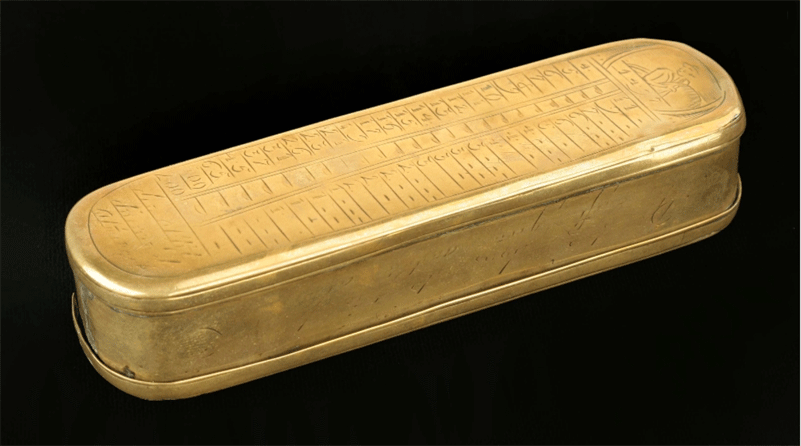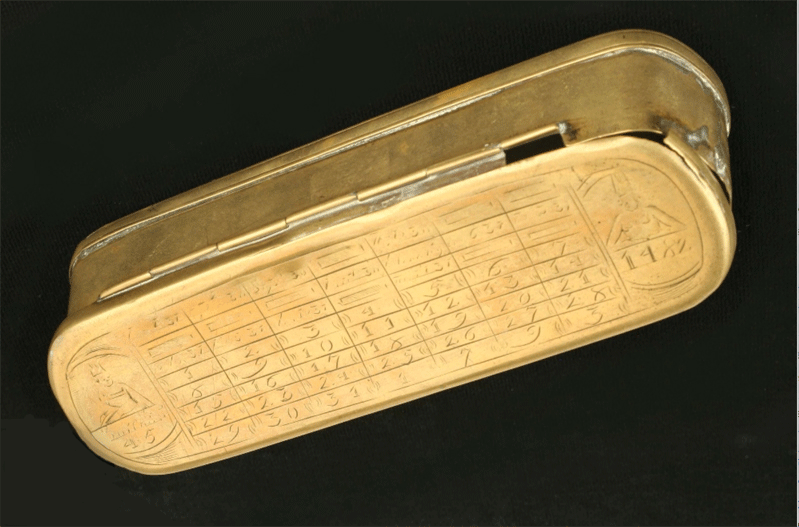 |
| Fig 1. Bottom of “Tobacco Box” showing table for calculating ship’s speed |
 |
| Fig 2. Top of “Tobacco Box” showing table for perpetual calendar |
Pietr Holm’s brass tobacco box consisting of a perpetual calendar on one side (Fig 1 - top picture) and a scale to calculate a ship’s speed in the nautical miles of the day travelled per hour on the other (Fig 2 - lower picture).
Pietr Holm was the Master of a Nautical School which he founded in Amsterdam in 1737. He was a strong proponent of a particular way of estimating a ship’s speed by determining the time taken for a sea feature (for example a patch of foam) to pass along two measured points on the ship’s hull. He hit on the idea of placing a conversion table for this approach on a brass tobacco box, which would make it conveniently available for the seaman, and he made these available for purchase by his students. The box in this collection is an example of the 20 or so known to still exist and is dated 1793 - the date being shown in the final four digits of the calendar.
The method by which the two tables could be used has been investigated by Ernest Crone1 from which the following précis is derived.
1. The Ship’s Speed Table (“Zee-Meeter”)
The table for ship’s speed represents what even for the time was a very conservative and, despite its author’s claims, potentially inaccurate method for estimating this vital number. An ancient method for estimating the average ship’s speed was to throw a wooden log into the sea and estimate how fast it moved from the ship.2 In the C16–17 Dutch sailors developed and began using a rope attached to a wooden object (often a shaped board - a “chip log”) which when it was thrown into the sea would allow the sailor to measure the number of knots in the rope played out over a fixed time - of around a half minute (as measured by a sand glass). The distance between knots used was normally around 47 feet 6 inches so that the number of knots run out over the half minute could be converted to a speed in the nautical miles used then travelled per hour.
Holm is dismissive of the use of the log since it might break, or otherwise fail, and how then could the sailor measure the ship’s speed? Better, he thought to have a method that did not require such technology more like the traditional “heaving of a log” to float past measured points on the hull. His table is therefore based on the time taken for a patch of foam or other marker in the sea to move from one mark on the ship’s hull near the bow to another near the stern. With the distance between the two marks set at 40 Rynland feet the sailor is to count in a fixed way to determine the time. “The basis of the count is that one must count fifty-four words in a half minute, from twenty to seventy-four, then one will not have to fear a wrong guess.”3 The table then count could then be read off the table provided on the tobacco box. Note however that the table is idiosyncratic in that the zeros are used to represent quarters of a mile so that 2000 is not two thousand but rather 2 and 3/4 miles.
Of the above Crone remarks, somewhat harshly, that “Holm’s method of determining a ship’s speed belongs among the many unsatisfactory ones that we have reviewed, methods that make the reader wonder how they ever could have led to the correct results.”4 Crone goes on to note: “In this respect he evidently could not free himself from the old practices which were supported by his conservative colleagues. This is the more remarkable in view of the fact that he was such an enthusiastic supporter of the use of the octant.”
Yet we should not be surprised that a teacher at the time might adhere to the “tried and true” methods of speed estimation that reflected his own training and experience, rather than taking up what he might see as more risky and technologically dependent methods. And whether or not particular methods of the day were “true” against other emerging possibilities at the time, or from the more modern perspectives of later times and accomplishments, Holm’s tobacco box gives an evocative illustration of the calculational methods that the common seaman would not infrequently use whilst trying to plot a course for his ship through the vast and treacherous seas.
2. The perpetual calendar.
The Dutch were amonst the earliest nations to adopt the Gregorian calendar. The cover of the box (Fig 2) is a clever tabulation of a perpetual calendar which remains accurate to this day. It can be seen to consist of seven columns with the numbers increasing by 7 in the four rows down each column.
Whilst partly obscured by several centuries of wear, it can be seen that the columns are headed by three further rows. The headings of the columns are: [col. 1] Janu(ary) 1/31 and Octo(her) 8/31; [col. 2] April 2/30 and Juli 5/31; [col. 3] Sept(ember) 8/30 and Dece(mber) 10/31; [col. 4] Juni 4/30; [col. 5] May 10/30, Feb(ruary) 2 /28–29, Mar(ch) 1/31; [col. 6] Agu(st) 6/31; [col.] 7 May 3/31.
The second number for each month clearly indicates the number of days in that month. The columns 1–7 represent the days of the week in which 1 January for that year (col. 1) fall. Thus if 1 Jan fell on a Wednesday, then going down the column so did Jan and October 8, 15, 22 and 29. Going to the next column Wednesday in April and July fall on 2, 9, 16, 23 and 30; and so on.
The first number for each date (e.g. 1 in Jan 1/31) gives the age of the moon on the first of the month and by looking up a table of “the establishment of the port”5 (which was provided in a book by Holm, but also in the almanacs of the day) this could enable the seaman to calculate high and low tides. To do this the seaman would use the Dominical Letter (indicating the day of the week repeated across a particular year), the Epact (the age of the Moon on 1 January of that year), and the Golden Number - given by the remainder of (the year date + 1)/19).6
1 Ernest Crone, Pieter Holm and His Tobacco Box, Tr. Prof. Dirk Brouwer, No. 24, The Marine Historical Association Inc, Mystic Connecticut USA, April 1953. (↑)
2 See for example Allen Mordica, “The Speed Log —History, Construction and Use” at http://www.navyandmarine.org/planspatterns/speedlog.htm viewed 30 October 2014 (↑)
3 Crone, Pieter Holm, op. cit. p. 11 quoting Pietr Holm (↑)
4 ibid, p. 12 (↑)
5 The establishment of the port has been defined as the average length of the period between the transit of the moon and the next high tide. (↑)
6 The quotient of (year date+1)/19 gives the number of cycles in the ecclesiastical calendar - see for example http://www.infoplease.com/encyclopedia/society/calendar-the-christian-ecclesiastical-calendar.html (↑)
Pages linked to this page
 This work by Jim Falk is licensed under a Creative Commons Attribution-NonCommercial-NoDerivs 3.0 Unported License Click on the logo to the left to see the terms on which you can use it.
This work by Jim Falk is licensed under a Creative Commons Attribution-NonCommercial-NoDerivs 3.0 Unported License Click on the logo to the left to see the terms on which you can use it.